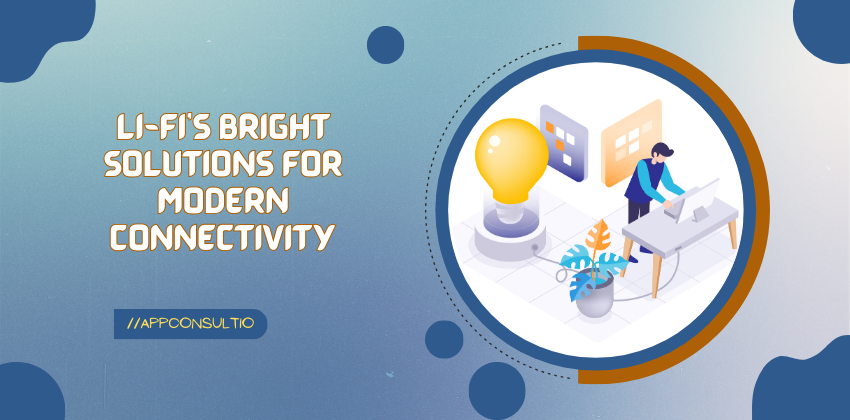
Li-Fi, short for Light Fidelity, is a groundbreaking wireless communication technology that uses LED lights to transmit data. In our world, where data communication is essential, traditional wireless networks can become slow and congested when many devices are connected. Li-Fi offers a new way to tackle this issue. Imagine using light to send information wirelessly instead of the radio waves used in Wi-Fi. Well, that's the core idea behind Li-Fi. It takes advantage of the visible light spectrum, a part of the electromagnetic spectrum we can see but not with our naked eyes. The key concept is that data can be sent through LED light by changing its brightness rapidly, much faster than our eyes can notice.
The concept of Li-Fi was first introduced by a German physicist named Harald Haas in 2011. He called it "data through illumination." Think of Li-Fi as Wi-Fi but with light bulbs as transmitters. Instead of Wi-Fi routers, we would have devices with LED lights that light up a room and send and receive data.
One of the significant advantages of Li-Fi is that it opens up a vast spectrum for data transmission compared to traditional wireless methods. It can provide about 400 terahertz of bandwidth, whereas conventional Wi-Fi only offers around 300 gigahertz. Plus, because Li-Fi uses visible light, it addresses concerns about the health effects of electromagnetic waves associated with Wi-Fi. Another exciting aspect of Li-Fi is its security. Since data transmission relies on light, it can only happen when there's light present. This means that in areas where security is crucial, like military facilities, Li-Fi can provide a safer option than traditional radio frequency communication, which can be susceptible to eavesdropping.
1. Education - In educational settings, fast and dependable internet access is essential for research, online learning, and collaboration. Li-Fi's rapid data transfer capabilities can provide students and educators with lightning-fast connectivity. This ensures that resource-heavy tasks like streaming educational videos, conducting virtual labs, and participating in live video conferences are seamless and efficient. Educational campuses often host many users simultaneously, putting a strain on traditional Wi-Fi networks. Li-Fi's ability to transmit data via light beams reduces network congestion, ensuring all users can access high-speed internet without slowdowns or disruptions.
2. Health Care - Operation theaters are highly controlled environments where precision and patient safety are paramount. Li-Fi, which relies on light for data transmission, eliminates this risk. It operates in a spectrum that doesn't disrupt or interfere with existing medical devices, ensuring the safety and reliability of crucial monitoring and surgical equipment. Li-Fi can enable real-time, high-speed data communication in OTs. Surgeons and medical staff can access critical medical records, imaging data, and research information instantly. This rapid access to information can significantly enhance the precision and efficiency of surgeries, especially in complex procedures like robotic surgery.
3. Underwater Exploration - Remotely Operated Vehicles (ROVs) are vital for underwater exploration and research. They rely on thick, cumbersome cables to transmit power and receive signals from operators on the surface. Replacing these cables with Li-Fi opens up new horizons. Li-Fi-equipped ROVs can operate more freely, with no tether constraints, allowing them to explore more extensive and remote underwater areas. Li-Fi-enabled ROVs can communicate with each other using their built-in headlamps. These underwater "flashlights" become more than illuminators; they become data transmitters. ROVs can share information, coordinate tasks, and collaborate on missions autonomously, which is especially valuable in complex underwater environments. Li-Fi provides high-speed data transmission, enabling ROVs to send their findings to the surface in real-time. This rapid data exchange is crucial for scientific research, underwater archaeology, and environmental monitoring.
4. Mobile Connectivity - Li-Fi's short-range network can deliver exceptionally high data rates, far exceeding traditional Wi-Fi. This means that mobile devices can transfer data between each other and access the internet at blazing speeds. Streaming high-definition videos, downloading large files, and conducting real-time video conferencing have become smoother and faster. Traditional Wi-Fi networks can become congested in crowded urban areas and densely populated spaces, leading to slower connections. Li-Fi's localized and focused coverage can alleviate this issue. Multiple Li-Fi networks can operate simultaneously nearby without interfering with each other, ensuring consistently high data rates. Li-Fi offers a higher level of security for mobile communications. Since Li-Fi relies on visible light and only works within its direct line of sight, it's more difficult for eavesdroppers to intercept data. This makes Li-Fi an attractive option for applications with paramount data privacy and security.
5. Emergency Communication - Subway stations and tunnels are typically challenging environments for wireless communication due to their enclosed nature. Li-Fi can penetrate these obstacles because it relies on visible light, which can pass through tunnels and reach users underground. This ensures that even in subway systems, people can stay connected during emergencies. In times of disaster, not everyone may be familiar with the specific communication protocols or technologies. Li-Fi is user-friendly; users only need to be within sight of a Li-Fi-enabled light source to connect. This simplicity makes it accessible to a broader range of people, including those who may not be tech-savvy. Emergency response teams can utilize Li-Fi to coordinate their efforts efficiently. Li-Fi-enabled devices can transmit critical information, such as maps, building layouts, and real-time updates, ensuring that first responders have the information required to carry out rescue and relief operations effectively.
Conclusion - In conclusion, Li-Fi technology is revolutionizing wireless communication by using light to transmit data, offering high-speed connectivity, and enhancing security. Its applications span various sectors, including education, healthcare, underwater exploration, mobile connectivity, and disaster response. Li-Fi's ability to operate in challenging environments and provide rapid, reliable connections makes it a promising technology for the future.